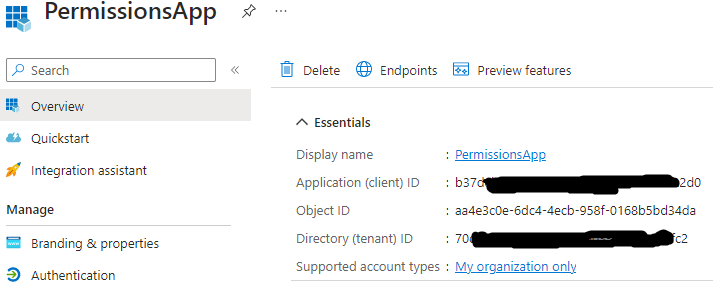Microsoft Graph is the gateway to data and intelligence in Microsoft 365. Microsoft Graph supports delegated and app-only access. Microsoft Graph exposes delegated and application permissions.
With delegated permissions, the app can access data on behalf of a signed-in user. Other names for delegated permissions are scopes and OAuth2 permissions.
Application permissions allow the app to access data with its own identity, without a signed-in user. Application permissions can be called app roles, app-only permissions, or direct access permissions.
Documentation contains details of both delegated and application permissions.
But what if you want to access those permissions programatically for further usage in your app or to export them?
Fortunately, the Graph API itself allows to get details of delegated and applications permissions.
Service principal
The servicePrincipal resource represents an instance of an application in Azure Active Directory. servicePrincipal has properties:
appId- the unique identifier for the associated applicationappRoles- the collection of the application roles exposed by the applicationoauth2PermissionScopes- the collection of the delegated permissions exposed by the application
The appRole can be assigned to users and groups or to other application. The appRole assigned to another application is also known as application permission.
Read permissions
In Azure Active Directory, create a new app with the application permission Application.Read.All which allows to read all servicePrincipal objects and their properties.

Create a new secret for the app:

I will use the Microsoft Graph PowerShell SDK to read and export permissions.
Install the latest release candidate of the Microsoft Graph module:
Install-Module -Name Microsoft.Graph -RequiredVersion "2.0.0-rc1" -AllowPrerelease
The latest release candidate allows you to connect to the Graph API with a client secret.
Use client id, tenant id, and secret:

Connect to the app in Azure AD:
$clientId = "<client_id>"
$tenantId = "<tenant_id>"
$secret = "<secret>"
$securedSecret = ConvertTo-SecureString -String $secret -AsPlainText -Force
$clientSecretCredential = New-Object `
-TypeName System.Management.Automation.PSCredential `
-ArgumentList $clientId, $securedSecret
Connect-MgGraph -TenantId $tenantId -ClientSecretCredential $clientSecretCredential
Read delegated and application permissions for the Microsoft Graph application:
Import-Module Microsoft.Graph.Applications
$data = Get-MgServicePrincipal -Filter "appId eq '00000003-0000-0000-c000-000000000000'" -Property "displayName,appRoles,oauth2PermissionScopes"
The Microsoft Graph application has the same app id 00000003-0000-0000-c000-000000000000 across all tenants, but if you want to be sure, you can either check the app id in Azure Active Directory or filter the app by name:
$data = Get-MgServicePrincipal -Filter "displayName eq 'Microsoft Graph'" -Property "displayName,appRoles,oauth2PermissionScopes"
Export permissions to csv:
$data.AppRoles | Where-Object { $_.AllowedMemberTypes -contains 'Application' } | Select-Object Value, Id, DisplayName, Description, Origin, IsEnabled | Export-Csv -Path $appPermissionsOutputFile -NoTypeInformation
$data.Oauth2PermissionScopes | Select-Object Value, Id, UserConsentDisplayName, UserConsentDescription, AdminConsentDescription, AdminConsentDisplayName, Type, IsEnabled | Export-Csv -Path $delegatedPermissionsOutputFile -NoTypeInformation
The whole script can be found in GitHub repository.
$appPermissionsOutputFile = ".\Graph_ApplicationPermissions.csv"
$delegatedPermissionsOutputFile = ".\Graph_DelegatedPermissions.csv"
$clientId = "<client_id>"
$tenantId = "<tenant_id>"
$secret = "<secret_value>"
$securedSecret = ConvertTo-SecureString `
-String $secret -AsPlainText -Force
$clientSecretCredential = New-Object `
-TypeName System.Management.Automation.PSCredential `
-ArgumentList $clientId, $securedSecret
Connect-MgGraph -TenantId $tenantId -ClientSecretCredential $clientSecretCredential
Import-Module Microsoft.Graph.Applications
$data = Get-MgServicePrincipal -Filter "appId eq '00000003-0000-0000-c000-000000000000'" -Property "displayName,appRoles,oauth2PermissionScopes"
$data.AppRoles | Where-Object { $_.AllowedMemberTypes -contains 'Application' } | Select-Object Value, Id, DisplayName, Description, Origin, IsEnabled | Export-Csv -Path $appPermissionsOutputFile -NoTypeInformation
$data.Oauth2PermissionScopes | Select-Object Value, Id, UserConsentDisplayName, UserConsentDescription, AdminConsentDescription, AdminConsentDisplayName, Type, IsEnabled | Export-Csv -Path $delegatedPermissionsOutputFile -NoTypeInformation
If you want to list permissions for other common applications, there is a list of their names with app id:
| Name | App id |
|---|---|
| Azure ESTS Service | 00000001-0000-0000-c000-000000000000 |
| Windows Azure Active Directory | 00000002-0000-0000-c000-000000000000 |
| Office 365 Exchange Online | 00000002-0000-0ff1-ce00-000000000000 |
| Microsoft Graph | 00000003-0000-0000-c000-000000000000 |
| Office 365 SharePoint Online | 00000003-0000-0ff1-ce00-000000000000 |
| Skype for Business Online | 00000004-0000-0ff1-ce00-000000000000 |
| Microsoft Azure Workflow | 00000005-0000-0000-c000-000000000000 |
| Yammer | 00000005-0000-0ff1-ce00-000000000000 |
| Microsoft Office 365 Portal | 00000006-0000-0ff1-ce00-000000000000 |
| Dataverse | 00000007-0000-0000-c000-000000000000 |
| Microsoft Exchange Online Protection | 00000007-0000-0ff1-ce00-000000000000 |
| Microsoft.Azure.DataMarket | 00000008-0000-0000-c000-000000000000 |
| Power BI Service | 00000009-0000-0000-c000-000000000000 |
| Microsoft Intune | 0000000a-0000-0000-c000-000000000000 |
| Microsoft Seller Dashboard | 0000000b-0000-0000-c000-000000000000 |
| Microsoft App Access Panel | 0000000c-0000-0000-c000-000000000000 |
| Microsoft Rights Management Services | 00000012-0000-0000-c000-000000000000 |
| Microsoft Power BI Information Service | 0000001b-0000-0000-c000-000000000000 |